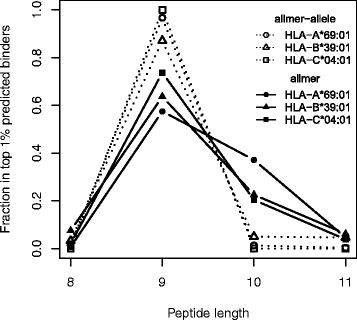NetMHCpan-3.0; improved prediction of binding to MHC class I molecules integrating information from multiple receptor and peptide length datasets
- PMID: 27029192
- PMCID: PMC4812631
- DOI: 10.1186/s13073-016-0288-x
NetMHCpan-3.0; improved prediction of binding to MHC class I molecules integrating information from multiple receptor and peptide length datasets
Abstract
Background: Binding of peptides to MHC class I molecules (MHC-I) is essential for antigen presentation to cytotoxic T-cells.
Results: Here, we demonstrate how a simple alignment step allowing insertions and deletions in a pan-specific MHC-I binding machine-learning model enables combining information across both multiple MHC molecules and peptide lengths. This pan-allele/pan-length algorithm significantly outperforms state-of-the-art methods, and captures differences in the length profile of binders to different MHC molecules leading to increased accuracy for ligand identification. Using this model, we demonstrate that percentile ranks in contrast to affinity-based thresholds are optimal for ligand identification due to uniform sampling of the MHC space.
Conclusions: We have developed a neural network-based machine-learning algorithm leveraging information across multiple receptor specificities and ligand length scales, and demonstrated how this approach significantly improves the accuracy for prediction of peptide binding and identification of MHC ligands. The method is available at www.cbs.dtu.dk/services/NetMHCpan-3.0 .
Figures






References
Publication types
MeSH terms
Substances
Grants and funding
LinkOut - more resources
Full Text Sources
Other Literature Sources
Medical
Research Materials

